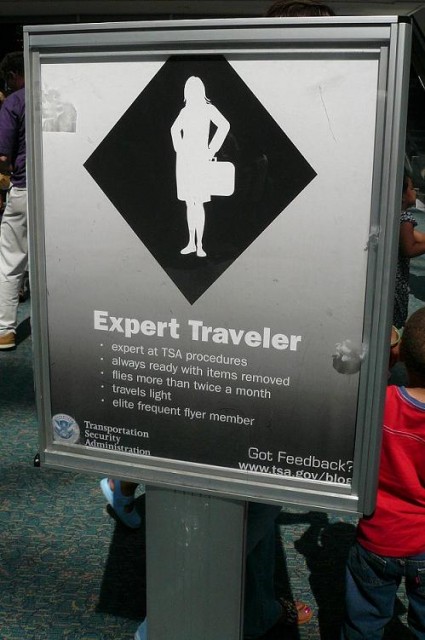I was recently invited to sit down with a local news outlet to discuss TSA’s Pre ✓™ program from the perspective of a frequent flyer who hadn’t signed up, and questions its utility as the program stands today. To be clear, I do not see the program as a threat to security. Instead, the program’s benefits simply aren’t compelling enough for me to part with $85 and take the time to be interviewed and fingerprinted.
$85 isn’t unreasonable, and there is even an interview site here in my Kansas City suburb. The idea of fingerprinting and background checks don’t bother me either since I’ve been through both as a basis for employment.
Instead, the “gotcha” for me is the fact that while having never signed up for TSA Pre✓™ I have experienced it first-hand many, many times, and I’m just not convinced on its utility to me as a semi-frequent traveler. But why? It comes down to what I like to call the “TSA Pre✓™ dilemma.”
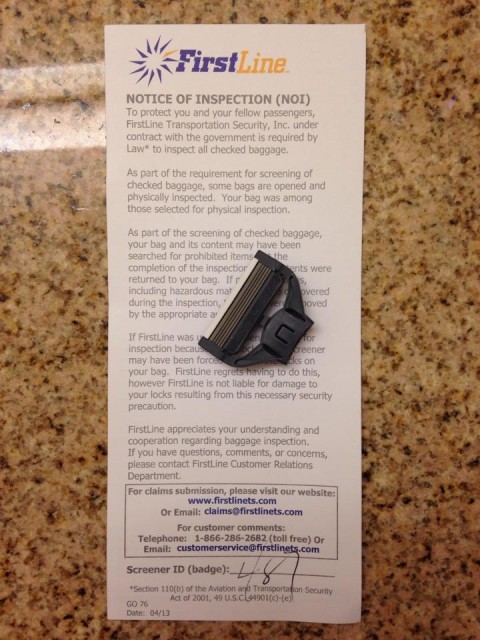
My razor head sans the handle, along with a notice of inspection, courtesy of the TSA Photo: JL Johnson | AirlineReporter
For years I’ve been a self-described “semi-frequent flyer.” That is, someone who travels just enough to almost make status, but ultimately fall short. Certainly, individual definitions of frequent and semi-frequent will vary, but that’s not the point. Recently, due to a promotion at work, I’m more keen on labeling myself a bona-fide “frequent flyer” now, having low-level status with two airlines.
As I’m spending more time at the airport I’ve learned a simple rule regarding the TSA: With the TSA, expect the unexpected. I have my fair share of stories; the time in Phoenix when I was waved into the Pre-Check line as a non-pre-check, non-premium customer only to stand around and wait as both explosives detection machines were calibrated at the same time. Or, the story about how at 4:30 AM on a Saturday I snapped this terrible photo of a non-existent security line at Kansas City International only to have a First Line (In KC TSA is contracted out to a vendor: First Line) officer in my face, chests touching, ready to fight for “taking his picture.”
And to be clear, the TSA and their First Line contractors here in Kansas City, MO are all human. Mistakes are made, and that’s just the way things go. But these irregularities could never have prepared me for the most recent, almost comical incident I experienced on a trip from KC to San Antonio.
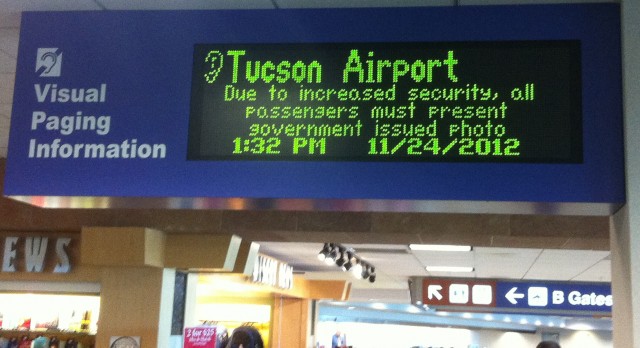
This sign is actually lying. This photos was taken via an iPhone just minutes before getting through security without valid photo ID.
This guest post was written by Jenny Brown, mother to David Parker Brown, the Founder of AirlineReporter.com. Notes in italics in the story are from David:
Unlike my son, a perfect flight is an uneventful flight. However, when I flew to Tucson in November, several events occurred that made my flight more of an adventure than I wanted.
It began when I boarded an Alaska Airlines flight from Seattle-Tacoma International Airport (SEA) to Tucson (TUS) on November 14, the only non-stop between the two cities. I usually fly first class (I was flying economy next to the lavatories -David) mainly because I am a reluctant flier and it allows me to relax more and get on and off the plane quickly.
So, the first class passengers were settling in when I heard the flight attendant say to the pilot, ’œSo, what’s wrong with the plane?’ Not something I wanted to hear! The voice on the intercom eventually told us that the co-pilot’s instruments were not working in the flight deck and it would take about two hours to fix. We deplaned to wait at the gate. Periodically, we were given updates and thanked for our patience. How the voice over the intercom knew we were being patient, I don’t know (Wait, isn’t this story about your ID mom? -David).
After a bit over two hours, we were told that another plane was being brought in and we eventually made it to Tucson.
While in Tucson, enjoying my family for Thanksgiving, I for some reason was looking in my purse for my driver’s license. I couldn’t find it. Yikes… I am undocumented in Arizona! (Let’s not get too political here -David). How am I going to get back to Seattle? What do I do? Call my son of course!
Luckily he helped out and emailed Alaska Airlines as I checked out their website as well as TSA’s. I also called Alaska Airlines and Cindy reassured me that I would make it home. Much to my surprise, I discovered that a photo ID is not necessary to fly, even though so many make you feel that it is required.
A list of other identification was given, including voter registration and social security card. I had both in my wallet as well as an expired passport with a 16 year-old photo. Thank goodness I don’t clean out my purse (I have since talked to my mom about having so many ID’s and identity theft, but that is another story – David).
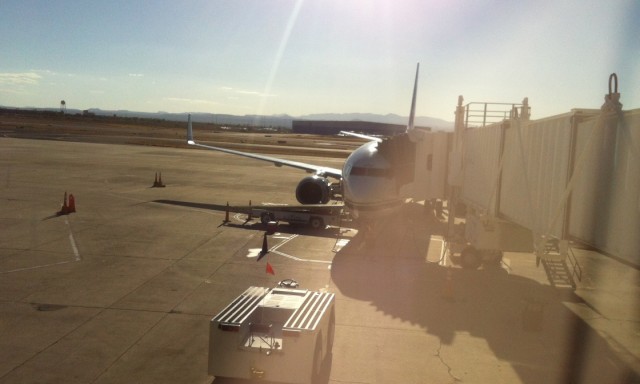
Top tier (that is sarcasm) iPhone photo of our Alaska 737 at TUS. Image by David (not that I really want to take credit).
I was still nervous about getting through TSA on the way home. Fortunately, David was returning on the same flight (he came down later), so he was there as son and journalist.
At the ticket counter, the Alaska agent was again very helpful (Well, technically, it was a Delta employee who was being contracted out to operate the counter for Alaska, but that is okay, she was very nice -David).
Then there was no line at security (Yea, that almost never happens -David). The TSA agent was very understanding and accepted the ID I had available. David was taking notes and photos; he seemed disappointed that I wasn’t whisked away to a room for ’œinterrogation’. Would make for a better story (No way, I am happy nothing bad went down. Although a nice frisking and detaining of my mom would have provided interesting content. -David).
Final Chapter: So after getting home safe and sound, I went to pick up my held mail at the post office the next day. The postal worker asked for a photo ID. I showed my voter’s registration and Social Security card to no avail. Finally, he reluctantly accepted my expired passport. I told him the postal service is tougher than the TSA. He said this is the US mail!
In my held mail was my driver’s license-sent by Alaska Airlines.
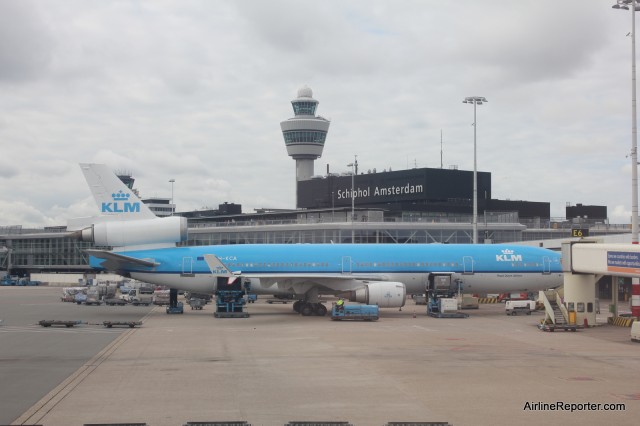
A KLM MD-11 at Amsterdam Airport Schiphol.
As you might know, I am not a fan of body scanners. They provide a false sense of security, violate your privacy, cost too much money and are easy to avoid. Even with all my travels, I have been proud being able to avoid a scan or pat down. In the US, the TSA makes it simple to choose a line that is not operating a body scanner. It is satisfying knowing that the TSA were not the ones that finally got me; it was the security at Amsterdam Airport Schiphol (AMS). Guess what? I am okay with it.
Security at Amsterdam is much better and thorough than anything I have experienced while traveling in the US. First off, there was a security check at the actual gate. Meaning they are dealing with a smaller group of people, where they can spend more time with each passenger. First, everyone has their passport and boarding pass reviewed, then scanned. Next, passengers stand one on one with a security person as they ask you questions about who you are, where you are going, etc. They are checking how you react and if any flags are raised to cause additional scrutiny. I was only asked a few questions and able to go, but many were there for much longer. It seems smart to have trained employees to detect any issues with an individual. I am guessing that they are paid more than your average TSA employee — and for good reason.
After your talk, it is time to have your bags and body scanned. Much like in the US, you place your bags on a belt, but in this case there was no avoiding the body scanner. Every passenger is required to go through the body scanner. That’s right… No picking or choosing which line to go through.
The security officers welcomed me into the body scanner and asked me how I was doing. This wasn’t some trick to see if I was a “bad guy,” this was just customer service.
I lifted my hands, the scanner went on and was nicely asked to exit the machine. Unlike in the US, where a mysterious person is hiding somewhere viewing your image, I could see my image right outside the scanner, but I was not worried. It was not an image of my naked body, but a representation of my body (think stick figure) and it indicated that I had something on my waist. I was told by the security guard that he needed to pat me down and he gently confirmed it was my belt and off I went.
If an airport or nation is going to operate body scanners, this is how it should be done. Yes, money has been spent on them, but they are also spending money on trained people who are actually friendly. Everyone was required to be scanned and I never felt that my privacy was being violated. If the TSA would move towards this model, maybe we could be friends.

Airports can be great places to hang out at after you get through security.
The last few years, the more I fly, the more I see body scanners. To date, even though many airports I travel to and from have body scanners, I have been able to avoid them — and pat-downs as well.
Don’t get me wrong. I am not about making a huge stand and doing whatever I can to avoid them. I just do what any normal passenger might try to avoid an additional delay at the airport.
Most of the time I fly out of Seattle-Tacoma International airport (SEA), where they have three main check points. At each check point there are multiple security lines and each line has access to a body scanner. Problem is, on many occasions there will be multiple lines open, but only one body scanner active.
A TSA agent will check my ID and boarding pass and then I have the ability to choose which security line I want. Of course, I choose a line that does not have a body scanner active and viola I have avoided the $150,000.00 high-tech scanner.
I have noticed at some airports there will be a second TSA employee telling you which line to go in, but often this person is missing or also easy to ignore if one wanted to. Could the TSA demand you go to line #1 with the body scanners and then escort you over? Sure, but that is a pretty embarrassing situation to put a person in, especially if it ends up being only people of a certain race.
This is not a big deal if someone who means airlines no harm can avoid the body scanners, but it would be just as easy for someone wanting to do harm. Take away all the privacy and health concerns; what is the point of spending all this money for the machines, training, and man-power to “keep us all safe,” if they can be consistently avoided? My father always told me, “if you are going to do something, do it right.” Sure, I didn’t always listen as a kid, but I think it is good advice for the TSA — I only hope they are listening.
How have your experiences with the body scanners gone? Have you noticed the same lack of consistency?
